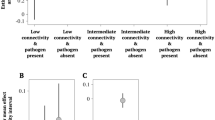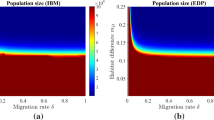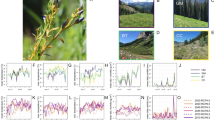Abstract
In recent years the potential for evolutionary change to drive ecological dynamics, and vice versa, has been widely recognized. However, the convincing examples of eco-evolutionary dynamics mainly stem from highly artificial experimental systems, with conspicuously few examples contributed by field systems. While rarely considered in the eco-evolutionary literature, the gene-for-gene hypothesis inherently recognizes the tight link between evolutionary and ecological dynamics. The boom-and-bust dynamics of some agricultural pathogens are an extreme demonstration of this. In this perspective, we place plant-pathogen systems in a spatial eco-evolutionary framework, which recognizes that ecology and evolution are tightly linked, take place at the same time scale and are strongly influenced by spatial structure. Specifically, we: i) exemplify how the ecological process of dispersal modifies rapid local coevolutionary dynamics and thereby shapes spatial variation in resistance, infectivity, and local adaptation; and ii) illustrate how the outcome of coevolution (spatial distribution in resistance, infectivity and local adaptation) drives ecological metapopulation processes. Overall, we conclude that both agricultural and wild pathosystems provide a unique illustration of the high relevance of spatial eco-evolutionary feedback in understanding species interactions.

Similar content being viewed by others
References
Agrawal, A. A., Hastings, A. P., Johnson, M. T. J., Maron, J. L., & Salminen, J.-P. (2012). Insect herbivores drive real-time ecological and evolutionary change in plant populations. Science, 338, 113–116.
Agrios, G. N. (2005). Plant pathology (5th ed.). New York: Academic.
Anagnostakis, S. L. (1987). Chestnut blight: the classical problem of an introduced pathogen. Mycologia, 79, 23–37.
Antonovics, J. (1992). Toward community genetics. In R. S. Fritz & E. L. Simms (Eds.), Plant resistance to herbivores and pathogens: ecology, evolution and genetics (pp. 426–449). Chicago: University of Chicago Press.
Antonovics, J., Thrall, P. H., Jarosz, A. M., & Stratton, D. (1994). Ecological genetics of metapopulations: the Silene-Ustilago plant-pathogen system. In L. A. Real (Ed.), Ecological genetics (pp. 146–170). Princeton: Princeton University Press.
Bailey, J. K., Schweitzer, J. A., Úbeda, F., Koricheva, J., LeRoy, C. J., Madritch, M. D., et al. (2009). From genes to ecosystems: a synthesis of the effects of plant genetic factors across levels of organization. Philosophical Transactions of the Royal Society, B: Biological Sciences, 364, 1607–1616.
Barbour, R. C., O’Reilly-Wapstra, J. M., De Little, D. W., Jordan, G. J., Steane, D. A., Humphreys, J. R., et al. (2009). A geographic mosaic of genetic variation within a foundation tree species and its community-level consequences. Ecology, 90, 1762–1772.
Bassar, R. D., Marshall, M. C., López-Sepulcre, A., Zandonà, E., Auer, S. K., Travis, J., et al. (2010). Local adaptation in Trinidadian guppies alters ecosystem processes. Proceedings of the National Academy of Sciences of the United States of America, 107, 3616–3621.
Becks, L., Ellner, S. P., Jones, L. E., & Hairston, N. G., Jr. (2010). Reduction of adaptive genetic diversity radically alters eco-evolutionary community dynamics. Ecology Letters, 13, 989–997.
Bergelson, J., & Purrington, C. B. (1996). Surveying patterns in the cost of resistance in plants. The American Naturalist, 148, 536–558.
Biere, A., & Antonovics, J. (1996). Sex-specific costs of resistance to the fungal pathogen Ustilago violacea (Microbotryum violaceum) in Silene alba. Evolution, 50, 1098–1110.
Biffen, R. H. (1905). Mendel’s laws of inheritance and wheat breeding. The Journal of Agricultural Science, 1, 4–48.
Bohannan, B. J. M., & Lenski, R. E. (2000). Linking genetic change to community evolution: insights from studies of bacteria and bacteriophage. Ecology Letters, 3, 362–377.
Brown, J. K. M., & Hovmøller, M. S. (2002). Aerial dispersal of pathogens on the global and continental scales and its impact on plant disease. Science, 297, 537–541.
Brown, J. K. M., & Tellier, A. (2011). Plant-parasite coevolution: bridging the gap between genetics and ecology. Annual Review of Phytopathology, 49, 345–367.
Burdon, J. J. (1987). Diseases and plant population biology. Cambridge: Cambridge University Press.
Burdon, J. J. (1993). The structure of pathogen populations in natural plant communities. Annual Review of Phytopathology, 31, 305–323.
Burdon, J. J., & Thrall, P. H. (2013). What have we learned from studies of wild plant-pathogen associations?—the dynamic interplay of time, space and life-history. European Journal of Plant Pathology. doi:10.1007/s10658-10013-10265-10659.
Burdon, J. J., Ericson, L., & Müller, W. J. (1995). Temporal and spatial changes in a metapopulation of the rust pathogen Triphragmium ulmariae and its host, Filipendula ulmaria. Journal of Ecology, 83, 979–989.
Busby, P. E., Newcombe, G., Dirzo, R., & Whitham, T. G. (2013). Genetic basis of pathogen community structure for foundation tree species in a common garden and in the wild. Journal of Ecology, 101, 867–877.
Capelle, J., & Neema, C. (2005). Local adaptation and population structure at a micro-geographical scale of a fungal parasite on its host plant. Journal of Evolutionary Biology, 18, 1445–1454.
Carlsson, U., & Elmqvist, T. (1992). Epidemiology of anther-smut disease (Microbotryum violaceum) and numeric regulation of populations of Silene dioica. Oecologia, 90, 509–517.
Carlsson-Granér, U. (1997). Anther-smut disease in Silene dioica: variation in susceptibility among genotypes and populations, and patterns of disease within populations. Evolution, 51, 1416–1426.
Carlsson-Granér, U., & Thrall, P. H. (2002). The spatial distribution of plant populations, disease dynamics and evolution of resistance. Oikos, 97, 97–110.
Carlsson-Granér, U., Burdon, J. J., & Thrall, P. H. (1999). Host resistance and pathogen virulence across a plant hybrid zone. Oecologia, 121, 339–347.
CIMMYT (2005). Sounding the alarm on global stem rust. http://www.globalrust.org/traction/permalink/about37@1
Deadman, M. L. (2006). Epidemiological consequences of plant disease resistance. In B. M. Cooke, D. Gareth Jones, & B. Kaye (Eds.), The epidemiology of plant diseases (2nd ed., pp. 139–157). Dordrecht: Springer.
Desprez-Loustau, M.-L., Robin, C., Buée, M., Courtecuisse, R., Garbaye, J., Suffert, F., et al. (2007). The fungal dimension of biological invasions. Trends in Ecology & Evolution, 22, 472–480.
Ellner, S. P. (2013). Rapid evolution: from genes to communities, and back again? Functional Ecology, 27, 1087–1099.
Ericson, L., Burdon, J. J., & Müller, W. J. (1999). Spatial and temporal dynamics of epidemics of the rust fungus Uromyces valerianae on populations of its host Valeriana salina. Journal of Ecology, 87, 649–658.
Ezard, T. H. G., Côté, S. D., & Pelletier, F. (2009). Eco-evolutionary dynamics: disentangling phenotypic, environmental and population fluctuations. Philosophical Transactions of the Royal Society, B: Biological Sciences, 364, 1491–1498.
Farkas, T. E., Mononen, T., Comeault, A. A., Hanski, I., & Nosil, P. (2013). Evolution of camouflage drives rapid ecological change in an insect community. Current Biology, 23, 1835–1843.
Flor, H. H. (1942). Inheritance of pathogenicity in Melampsora lini. Phytopathology, 32, 653–669.
Flor, H. H. (1956). The complementary genic systems in flax and flax rust. Advances in Genetics, 8, 29–54.
Fussmann, G. F., Loreau, M., & Abrams, P. A. (2007). Eco-evolutionary dynamics of communities and ecosystems. Functional Ecology, 21, 465–477.
Gandon, S. (2002). Local adaptation and the geometry of host-parasite coevolution. Ecology Letters, 5, 246–256.
Gandon, S., & Michalakis, Y. (2002). Local adaptation, evolutionary potential and host-parasite coevolution: interactions between migration, mutation, population size and generation time. Journal of Evolutionary Biology, 15, 451–462.
Gandon, S., Capowiez, Y., Dubois, Y., Michalakis, Y., & Olivieri, I. (1996). Local adaptation and gene-for-gene coevolution in a metapopulation model. Proceedings of the Royal Society B: Biological Sciences, 263, 1003–1009.
Gibert, J. P., Pires, M. M., Thompson, J. N., & Guimarães, P. R. (2013). The spatial structure of antagonistic species affects coevolution in predictable ways. The American Naturalist, 182, 578–591.
Giles, B. E., Pettersson, T. M., Carlsson-Granér, U., & Ingvarsson, P. K. (2006). Natural selection on floral traits of female Silene dioica by a sexually transmitted disease. New Phytologist, 169, 729–739.
Grant, P. R., & Grant, B. R. (2006). Evolution of character displacement in Darwin’s finches. Science, 313, 224–226.
Hairston, N. G., Ellner, S. P., Geber, M. A., Yoshida, T., & Fox, J. A. (2005). Rapid evolution and the convergence of ecological and evolutionary time. Ecology Letters, 8, 1114–1127.
Hanski, I. A. (2011). Eco-evolutionary spatial dynamics in the Glanville fritillary butterfly. Proceedings of the National Academy of Sciences, 108, 14397–14404.
Hanski, I. (2012). Eco-evolutionary dynamics in a changing world. Annals of the New York Academy of Sciences, 1249, 1–17.
Hanski, I., & Gaggiotti, O. (2004). Ecology, genetics and evolution of metapopulations. Amsterdam: Elsevier Academic Press.
Hanski, I., Mononen, T., & Ovaskainen, O. (2011). Eco-evolutionary metapopulation dynamics and the spatial scale of adaptation. The American Naturalist, 177, 29–43.
Harmon, L. J., Matthews, B., Des Roches, S., Chase, J. M., Shurin, J. B., & Schluter, D. (2009). Evolutionary diversification in stickleback affects ecosystem functioning. Nature, 458, 1167–1170.
Hutchinson, G. E. (1965). The ecological theater and the evolutionary play. New Haven: Yale University Press.
Janzen, D. H. (1980). When is it coevolution. Evolution, 34, 611–612.
Jarosz, A. M., & Burdon, J. J. (1991). Host-pathogen interactions in natural populations of Linum marginale and Melampsora lini: II. Local and regional variation in patterns of resistance and racial structure. Evolution, 45, 1618–1627.
Jones, E. I., Ferrière, R., & Bronstein, J. L. (2009). Eco-evolutionary dynamics of mutualists and exploiters. The American Naturalist, 174, 780–794.
Kaltz, O., & Shykoff, J. A. (1998). Local adaptation in host-parasite systems. Heredity, 81, 361–370.
Kaltz, O., Gandon, S., Michalakis, Y., & Shykoff, J. A. (1999). Local maladaptation in the anther-smut fungus Microbotryum violaceum to its host plant Silene latifolia: evidence from a cross-inoculation experiment. Evolution, 53, 395–407.
Laine, A.-L. (2004). Resistance variation within and among host populations in a plant–pathogen metapopulation: implications for regional pathogen dynamics. Journal of Ecology, 92, 990–1000.
Laine, A.-L. (2005). Spatial scale of local adaptation in a plant-pathogen metapopulation. Journal of Evolutionary Biology, 18, 930–938.
Laine, A.-L., & Hanski, I. (2006). Large-scale spatial dynamics of a specialist plant pathogen in a fragmented landscape. Journal of Ecology, 94, 217–226.
Laine, A.-L., Burdon, J. J., Dodds, P. N., & Thrall, P. H. (2011). Spatial variation in disease resistance: from molecules to metapopulations. Journal of Ecology, 99, 96–112.
Lenormand, T. (2002). Gene flow and the limits to natural selection. Trends in Ecology & Evolution, 17, 183–189.
Losos, J. B. (1994). Integrative approaches to evolutionary ecology: Anolis lizards as model systems. Annual Review of Ecology and Systematics, 25, 467–493.
Luo, S., & Koelle, K. (2013). Navigating the devious course of evolution: the importance of mechanistic models for identifying eco-evolutionary dynamics in nature. The American Naturalist, 181, S58–S75.
McDonald, B. A., & Linde, C. (2002). Pathogen population genetics, evolutionary potential, and durable resistance. Annual Review of Phytopathology, 40, 349–379.
Mundt, C. C. (2002). Use of multiline cultivars and cultivar mixtures for disease management. Annual Review of Phytopathology, 40, 381–410.
Pelletier, F., Garant, D., & Hendry, A. P. (2009). Eco-evolutionary dynamics. Philosophical Transactions of the Royal Society, B: Biological Sciences, 364, 1483–1489.
Peterson, P. D., Leonard, K. J., Roelfs, A. P., & Sutton, T. B. (2005). Effect of barberry eradication on changes in populations of Puccinia graminis in Minnesota. Plant Disease, 89, 935–940.
Petrželová, I., & Lebeda, A. (2004). Occurrence of Bremia lactucae in natural populations of Lactuca serriola. Journal of Phytopathology, 152, 391–398.
Pimentel, D. (1968). Population regulation and genetic feedback: evolution provides foundation for control of herbivore, parasite, and predator numbers in nature. Science, 159, 1432–1437.
Post, D. M., & Palkovacs, E. P. (2009). Eco-evolutionary feedbacks in community and ecosystem ecology: interactions between the ecological theatre and the evolutionary play. Philosophical Transactions of the Royal Society, B: Biological Sciences, 364, 1629–1640.
Pretorius, Z. A., Singh, R. P., Wagoire, W. W., & Payne, T. S. (2000). Detection of virulence to wheat stem rust resistance gene Sr31 in Puccinia graminis f. sp. tritici in Uganda. Plant Disease, 84, 203.
Reznick, D. N. (2013). A critical look at reciprocity in ecology and evolution: introduction to the symposium. The American Naturalist, 181, S1–S8.
Roelfs, A. P. (1982). Effects of barberry eradication on stem rust in the United States. Plant Disease, 66, 177–181.
Roslin, T., Laine, A.-L., & Gripenberg, S. (2007). Spatial population structure in an obligate plant pathogen colonizing oak Quercus robur. Functional Ecology, 21, 1168–1177.
Sacristán, S., Vigouroux, M., Pedersen, C., Skamnioti, P., Thordal-Christensen, H., Micali, C., et al. (2009). Coevolution between a family of parasite virulence effectors and a class of LINE-1 retrotransposons. PLoS ONE, 4, e7463.
Schoener, T. W. (2011). The newest synthesis: understanding the interplay of evolutionary and ecological dynamics. Science, 331, 426–429.
Singh, R. P., Hodson, D. P., Huerta-Espino, J., Jin, Y., Bhavani, S., Njau, P., et al. (2011). The emergence of Ug99 races of the stem rust fungus is a threat to world wheat production. Annual Review of Phytopathology, 49, 465–481.
Slobodkin, L. B. (1961). Growth and regulation of animal populations. New York: Holt, Rinehart and Winston.
Smith, D. L., Ericson, L., & Burdon, J. J. (2011). Co-evolutionary hot and cold spots of selective pressure move in space and time. Journal of Ecology, 99, 634–641.
Sprague, S. J., Balesdent, M.-H., Brun, H., Hayden, H. L., Marcroft, S. J., Pinochet, X., et al. (2006). Major gene resistance in Brassica napus (oilseed rape) is overcome by changes in virulence of populations of Leptosphaeria maculans in France and Australia. European Journal of Plant Pathology, 114, 33–40.
Springer, Y. P. (2007). Clinal resistance structure and pathogen local adaptation in a serpentine flax-flax rust interaction. Evolution, 61, 1812–1822.
Stokstad, E. (2007). Deadly wheat fungus threatens world’s breadbaskets. Science, 315, 1786–1787.
Strauss, S. Y. (2013). Ecological and evolutionary responses in complex communities: implications for invasions and eco-evolutionary feedbacks. Oikos. doi:10.1111/j.1600-0706.2013.01093.x.
Susi, H., & Laine, A.-L. (2013). Pathogen life-history trade-offs revealed in allopatry. Evolution, 67, 3362–3370.
Tack, A. J. M., Thrall, P. H., Barrett, L. G., Burdon, J. J., & Laine, A.-L. (2012). Variation in infectivity and aggressiveness in space and time in wild host–pathogen systems: causes and consequences. Journal of Evolutionary Biology, 25, 1918–1936.
Tack, A. J. M., Hakala, J., Petäjä, T., Kulmala, M., & Laine, A.-L. (2013a). Genotype and spatial structure shape pathogen dispersal and disease dynamics at small spatial scales. Ecology. doi:10.1890/1813-0518.1891.
Tack, A. J. M., Horns, F., & Laine, A.-L. (2013b). The impact of spatial scale and habitat configuration on patterns of trait variation and local adaptation in a wild plant parasite. Evolution. doi:10.1111/evo.12239.
Tellier, A., & Brown, J. K. M. (2011). Spatial heterogeneity, frequency-dependent selection and polymorphism in host-parasite interactions. BMC Evolutionary Biology, 11, 319.
Thompson, J. N. (2005). The geographic mosaic of coevolution. Chicago: University of Chicago Press.
Thompson, J. N. (2013). Relentless evolution. Chicago: University of Chicago Press.
Thompson, J. N., & Burdon, J. J. (1992). Gene-for-gene coevolution between plants and parasites. Nature, 360, 121–125.
Thrall, P. H., & Antonovics, J. (1995). Theoretical and empirical studies of metapopulations: population and genetic dynamics of the Silene–Ustilago system. Canadian Journal of Botany, 73, S1249–S1258.
Thrall, P. H., & Burdon, J. J. (1997). Host-pathogen dynamics in a metapopulation context: the ecological and evolutionary consequences of being spatial. Journal of Ecology, 85, 743–753.
Thrall, P. H., & Burdon, J. J. (1999). The spatial scale of pathogen dispersal: consequences for disease dynamics and persistence. Evolutionary Ecology Research, 1, 681–701.
Thrall, P. H., & Burdon, J. J. (2002). Evolution of gene-for-gene systems in metapopulations: the effect of spatial scale of host and pathogen dispersal. Plant Pathology, 51, 169–184.
Thrall, P. H., & Jarosz, A. M. (1994). Host-pathogen dynamics in experimental populations of Silene alba and Ustilago violacea. II. Experimental tests of theoretical models. Journal of Ecology, 82, 561–570.
Thrall, P. H., Burdon, J. J., & Bock, C. H. (2001). Short-term epidemic dynamics in the Cakile maritima–Alternaria brassicicola host–pathogen association. Journal of Ecology, 89, 723–735.
Thrall, P. H., Burdon, J. J., & Bever, J. D. (2002). Local adaptation in the Linum marginale—Melampsora lini host-pathogen interaction. Evolution, 56, 1340–1351.
Thrall, P. H., Laine, A.-L., Ravensdale, M., Nemri, A., Dodds, P. N., Barrett, L. G., et al. (2012). Rapid genetic change underpins antagonistic coevolution in a natural host-pathogen metapopulation. Ecology Letters, 15, 425–435.
Tian, D., Traw, M. B., Chen, J. Q., Kreitman, M., & Bergelson, J. (2003). Fitness costs of R-gene-mediated resistance in Arabidopsis thaliana. Nature, 423, 74–77.
Toju, H. (2011). Weevils and camellias in a Darwin’s race: model system for the study of eco-evolutionary interactions between species. Ecological Research, 26, 239–251.
Van de Wouw, A. P., Cozijnsen, A. J., Hane, J. K., Brunner, P. C., McDonald, B. A., Oliver, R. P., et al. (2010a). Evolution of linked avirulence effectors in Leptosphaeria maculans is affected by genomic environment and exposure to resistance genes in host plants. PLoS Pathogens, 6, e1001180.
Van de Wouw, A. P., Stonard, J. F., Howlett, B. J., West, J. S., Fitt, B. D. L., & Atkins, S. D. (2010b). Determining frequencies of avirulent alleles in airborne Leptosphaeria maculans inoculum using quantitative PCR. Plant Pathology, 59, 809–818.
Vogwill, T., Fenton, A., & Brockhurst, M. A. (2010). How does spatial dispersal network affect the evolution of parasite local adaptation? Evolution, 64, 1795–1801.
Whitham, T. G., Bailey, J. K., Schweitzer, J. A., Shuster, S. M., Bangert, R. K., Leroy, C. J., et al. (2006). A framework for community and ecosystem genetics: from genes to ecosystems. Nature Reviews Genetics, 7, 510–523.
Wolfe, M. S. (1985). The current status and prospects of multiline cultivars and variety mixtures for disease resistance. Annual Review of Phytopathology, 23, 251–273.
Yahiaoui, N., Brunner, S., & Keller, B. (2006). Rapid generation of new powdery mildew resistance genes after wheat domestication. The Plant Journal, 47, 85–98.
Yoshida, T., Jones, L. E., Ellner, S. P., Fussmann, G. F., & Hairston, N. G., Jr. (2003). Rapid evolution drives ecological dynamics in a predator–prey system. Nature, 424, 303–306.
Acknowledgments
This work was supported by funding from the Academy of Finland (Grant Nos 250444, 136393, 133499) and European Research Council (PATHEVOL; 281517) to ALL and a grant from the Academy of Finland to AT (Grant No 265761).
Author information
Authors and Affiliations
Corresponding author
Rights and permissions
About this article
Cite this article
Tack, A.J.M., Laine, AL. Spatial eco-evolutionary feedback in plant-pathogen interactions. Eur J Plant Pathol 138, 667–677 (2014). https://doi.org/10.1007/s10658-013-0353-x
Accepted:
Published:
Issue Date:
DOI: https://doi.org/10.1007/s10658-013-0353-x




